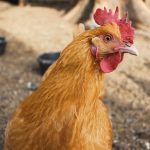Brown chicken breeds have a rich history that spans thousands of years. The domestication of chickens is believed to have originated in Southeast Asia approximately 8,000 years ago, with subsequent spread to Europe and Africa. These breeds have been integral to human agriculture for centuries, providing both meat and eggs as valuable food sources.
The development of specific brown chicken breeds can be attributed to selective breeding practices. Farmers and breeders historically sought to enhance desirable traits such as egg-laying capacity, meat quality, and adaptability to various climates. This process of artificial selection has led to the diverse range of brown chicken breeds we see today.
During the 19th and 20th centuries, brown chicken breeds gained significant popularity in the United States and Europe, coinciding with the rise of industrialized farming. Breeders focused on creating birds that efficiently converted feed into eggs and meat, resulting in specialized brown chicken breeds for both egg and meat production. In contemporary agriculture, brown chicken breeds continue to play a crucial role, providing a sustainable protein source for global consumption.
The evolution of these breeds demonstrates human ingenuity in harnessing and enhancing the natural capabilities of chickens to benefit society.
Table of Contents
Key Takeaways
- Brown chicken breeds have a long history, with some breeds dating back to the 19th century.
- Brown chickens are known for their hardiness, good egg-laying abilities, and friendly dispositions.
- Popular brown chicken breeds for egg production include the Rhode Island Red, Plymouth Rock, and Sussex.
- Brown chicken breeds like the Orpington and Marans are known for their meat production qualities.
- Rare and heritage brown chicken breeds, such as the Buckeye and Java, are valued for their genetic diversity and historical significance.
- Caring for and raising brown chicken breeds involves providing proper housing, nutrition, and healthcare.
- The future of brown chicken breeds in agriculture looks promising, as they continue to be valued for their versatility and productivity.
Characteristics and Physical Attributes of Brown Chickens
Physical Characteristics
Most brown chicken breeds have sturdy, medium-sized bodies with well-developed musculature, making them well-suited for both egg and meat production. Their feathers can range from light tan to deep mahogany, with some breeds exhibiting striking patterns and color variations.
Temperament and Adaptability
Brown chicken breeds are known for being hardy and adaptable, able to thrive in a variety of climates and environments. They are generally good foragers and can be raised in free-range or confined settings.
Egg-Laying and Meat Production
Brown chickens are also known for their excellent egg-laying abilities, with many breeds laying large brown eggs with strong shells. Some brown chicken breeds are also valued for their meat quality, with tender and flavorful meat that is prized by chefs and home cooks alike.
Overall, brown chicken breeds are prized for their combination of practicality, beauty, and utility, making them a popular choice for farmers and backyard poultry enthusiasts alike.
Popular Brown Chicken Breeds for Egg Production

Several brown chicken breeds are renowned for their exceptional egg-laying abilities, making them popular choices for commercial egg production as well as backyard flocks. One of the most well-known brown chicken breeds for egg production is the Rhode Island Red. This breed is prized for its large brown eggs and hardy nature, making it a favorite among small-scale farmers and homesteaders.
Another popular brown chicken breed for egg production is the Plymouth Rock, which is known for its consistent egg-laying and calm temperament. The Sussex is another brown chicken breed that excels in egg production, with hens laying a high number of large brown eggs throughout the year. In addition to these breeds, the Orpington and Marans are also highly regarded for their egg-laying abilities.
Orpingtons are known for their gentle disposition and large brown eggs, while Marans are famous for their dark chocolate-colored eggs, which are prized by chefs and egg enthusiasts. These popular brown chicken breeds for egg production are valued for their reliability, adaptability, and ability to thrive in a variety of farming systems. Whether raised in small backyard flocks or large commercial operations, these brown chicken breeds continue to be sought after for their exceptional egg-laying capabilities.
Brown Chicken Breeds for Meat Production
While many brown chicken breeds are valued for their egg-laying abilities, there are also several breeds that excel in meat production. One of the most popular brown chicken breeds for meat production is the New Hampshire Red. This breed is known for its rapid growth rate and well-developed musculature, making it an excellent choice for meat production.
Another popular brown chicken breed for meat production is the Barred Plymouth Rock, which is prized for its flavorful and tender meat. The Cornish Cross is another brown chicken breed that is widely used in commercial meat production due to its fast growth rate and high meat yield. In addition to these breeds, the Jersey Giant and Buckeye are also valued for their meat quality.
Jersey Giants are one of the largest chicken breeds, making them an excellent choice for meat production, while Buckeyes are known for their richly flavored meat and efficient feed conversion. These brown chicken breeds for meat production are sought after by farmers and consumers alike for their superior meat quality and efficiency in converting feed into protein. Whether raised on pasture-based systems or in confinement, these brown chicken breeds continue to play a vital role in meeting the demand for high-quality poultry meat.
Rare and Heritage Brown Chicken Breeds
In addition to popular commercial brown chicken breeds, there are also rare and heritage breeds that are valued for their unique characteristics and historical significance. One such breed is the Chantecler, which is the only chicken breed developed in Canada. Chanteclers are known for their cold-hardiness and ability to thrive in northern climates, making them an important breed for preserving genetic diversity in poultry populations.
Another rare brown chicken breed is the Buckeye, which was developed in Ohio and is known for its mahogany-colored feathers and excellent meat quality. The Java is another heritage brown chicken breed that has a rich history dating back to the early days of American agriculture. Javas are valued for their dual-purpose capabilities, excelling in both egg production and meat quality.
The Dominique is another rare brown chicken breed that has been recognized as America’s first chicken breed, with a long history dating back to colonial times. These rare and heritage brown chicken breeds play an important role in preserving genetic diversity within poultry populations and providing valuable genetic resources for future breeding programs.
Caring for and Raising Brown Chicken Breeds

Providing a Suitable Living Environment
Whether raised in free-range systems or confinement, it’s important to provide ample space for chickens to move around and exhibit natural behaviors such as scratching, dust bathing, and perching.
Maintaining Health and Preventing Disease
Regular health checks and preventative measures such as vaccinations can help prevent common poultry diseases and ensure a thriving flock. In addition to physical care, it’s important to consider the social needs of brown chickens.
Chickens are social animals that thrive in flocks, so providing opportunities for social interaction and enrichment can contribute to their overall well-being. For example, providing access to outdoor areas where chickens can roam and explore can help reduce stress and promote natural behaviors. Additionally, providing nesting boxes filled with clean bedding material can encourage hens to lay eggs in a safe and comfortable environment. By understanding the specific needs of brown chicken breeds and providing attentive care, farmers and backyard poultry enthusiasts can ensure the health and productivity of their flocks.
The Future of Brown Chicken Breeds in Agriculture
As agriculture continues to evolve, the future of brown chicken breeds remains promising as they continue to play a vital role in meeting the demand for sustainable protein sources. With increasing interest in small-scale farming and backyard poultry keeping, there is growing appreciation for the diverse characteristics and utility of brown chicken breeds. Additionally, as consumers become more conscious of animal welfare and environmental sustainability, there is a renewed interest in heritage and rare brown chicken breeds that offer unique qualities and genetic diversity.
Advancements in breeding techniques and genetic selection offer opportunities to further improve the productivity and resilience of brown chicken breeds while preserving their valuable genetic traits. As global food systems face challenges such as climate change and resource scarcity, the adaptability and efficiency of brown chicken breeds will be increasingly important in meeting the demand for high-quality eggs and meat. By promoting responsible breeding practices and conservation efforts, the future of brown chicken breeds in agriculture looks bright as they continue to contribute to sustainable food production and genetic diversity within poultry populations.
In conclusion, the history of brown chicken breeds is rich with tradition and innovation, dating back thousands of years to their domestication in ancient times. Today, these versatile birds continue to play a crucial role in agriculture, providing a sustainable source of protein through their exceptional egg-laying abilities and superior meat quality. Whether raised for commercial production or as part of small-scale farming operations, brown chicken breeds offer a combination of practicality, beauty, and utility that make them valued members of agricultural communities around the world.
As we look towards the future, it’s clear that brown chicken breeds will continue to be an integral part of sustainable food systems, contributing to genetic diversity and meeting the evolving needs of consumers and farmers alike.
If you’re interested in learning more about chicken coops for your brown chickens, check out this article on the Producers Pride Sentinel Chicken Coop from Poultry Wizard. This coop is designed to provide a safe and comfortable environment for your chickens, ensuring they have everything they need to thrive. Whether you’re a beginner or experienced chicken owner, this coop could be a great option for your flock. (source)
FAQs
What are some common breeds of brown chickens?
Some common breeds of brown chickens include Rhode Island Red, Plymouth Rock, Orpington, and Sussex.
What are the characteristics of brown chickens?
Brown chickens typically have brown feathers, although the shade of brown can vary between breeds. They are known for being good layers of brown eggs and are often valued for their friendly and docile nature.
What are the advantages of raising brown chickens?
Brown chickens are known for their hardiness, good egg production, and friendly disposition, making them popular choices for backyard chicken keepers. Additionally, their brown eggs are often preferred by consumers.
What are some considerations when raising brown chickens?
When raising brown chickens, it’s important to provide them with a suitable coop and run, as well as access to fresh water and a balanced diet. Additionally, proper predator protection and regular health checks are essential for their well-being.
Are there any specific care requirements for brown chickens?
Brown chickens have similar care requirements to other chicken breeds, including regular access to clean water, a balanced diet, protection from predators, and appropriate shelter. Additionally, they may benefit from dust baths for grooming and parasite control.
Meet Walter, the feathered-friend fanatic of Florida! Nestled in the sunshine state, Walter struts through life with his feathered companions, clucking his way to happiness. With a coop that’s fancier than a five-star hotel, he’s the Don Juan of the chicken world. When he’s not teaching his hens to do the cha-cha, you’ll find him in a heated debate with his prized rooster, Sir Clucks-a-Lot. Walter’s poultry passion is no yolk; he’s the sunny-side-up guy you never knew you needed in your flock of friends!







